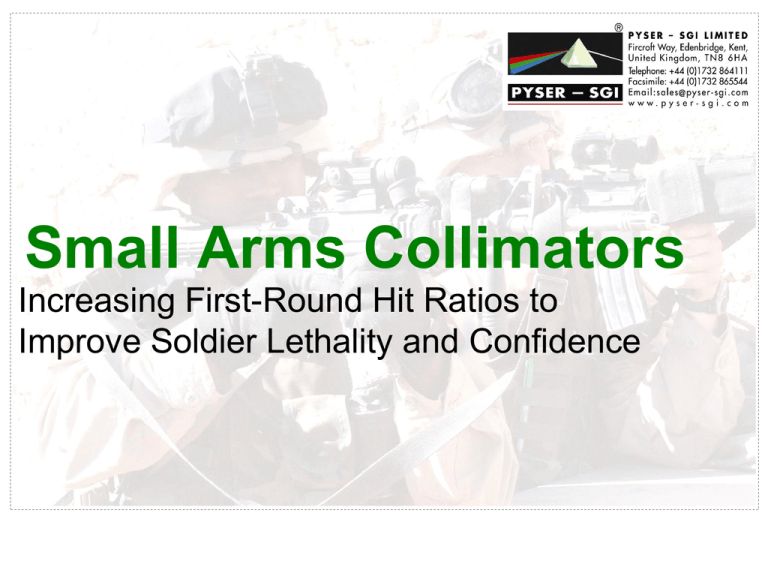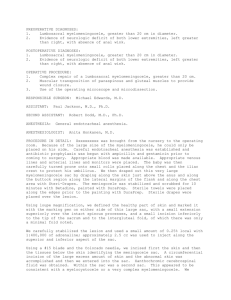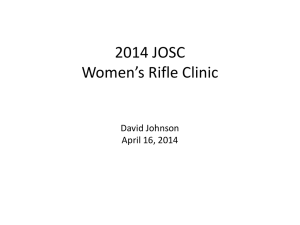Power Point Presentation
advertisement

Small Arms Collimators Increasing First-Round Hit Ratios to Improve Soldier Lethality and Confidence Realities of Today’s Battlefield Soldiers are changing sights frequently to meet mission requirements/ environments. Repeatability of sights following removal and re-mounting is questionable. The operational environment often does not allow soldiers to fire to confirm zero and/ or re-zero, if necessary. Urban environment, enemy tactics, and presence of non-combatants make precision engagement critical. Francis Barker Small Arms Collimator (SAC) The Francis Barker SAC is a precision optical device that allows soldiers to confirm zero and/ or re-zero weapons in the field, to a high level of accuracy, without live fire. They are manufactured and calibrated very precisely in order to ensure that any collimator can be used on any like weapon with the exact same results/ level of accuracy. SACs work with iron sights, optical sights, and night vision sights. They are available for assault rifles, submachine guns, machine guns, sniper rifles, and grenade launchers. Laser collimators are available for use with visible and IR laser aiming systems. Key Features Accurate: sub-MOA accuracy (0.25 mils, 2.5cm@100m). Repeatable: any collimator can be used on any like weapon system with the same degree of accuracy. Passive: does not emit light or any other signature and does not require a down-range target. Simple: easy to use with very little training. No ‘master weapon’ is needed. No adjustments or maintenance. No batteries. Proven: SACs have been in use for more than a decade by British and other military forces with outstanding results. Key Benefits • • Adjust or confirm zero on weapon systems in under one minute: – after changing sights; – after changing weapons; – during pre-combat checks, or; – at snipers’ Final Firing Position (FFP). Reduced range time and ammunition requirements for initial zeroing. Components of the SAC Optical Housing Tritium Light Source Main Body Specification Plate Rubber Spacer Spigot Instructions for Use Establishing Personal Zero Position (PZP): 1. ENSURE that the weapon is CLEAR. 2. If possible, apply a light coat of oil to the collimator spigot. 3. Carefully insert the spigot into the barrel of the weapon. The collimator’s rubber buffer should lightly contact the end of the barrel. 4. Take up a normal firing position. 5. Rotate the SAC to vertical position (as exact as possible). 6. Adjust sight to exact center/ initial zero position of SAC grid. 7. Remove the SAC and conduct standard live fire zero procedures. 8. Repeat steps 1-5. 9. Note exact position of sight on SAC grid. 10. Record grid position, type of sight, and range. This is the shooter’s PZP for that sight and range. E 7 9 G Instructions for Use Confirming or Re-Zeroing Weapon to PZP: 1. ENSURE that the weapon is CLEAR. 2. If possible, apply a light coat of oil to the collimator spigot. 3. Carefully insert the spigot into the barrel of the weapon. The collimator’s rubber buffer should lightly contact the end of the barrel. 4. Take up a normal firing position. 5. Rotate the SAC to vertical position. 6. Adjust sight to PZP. 7. Remove the SAC and repeat to ensure accuracy. Conclusion Small Arms Collimators solve a critical problem by providing soldiers with complete confidence in their weapons after changing sights or changing weapons, or after exposing weapons to the bumps and knocks inherent to infiltration and movement on the battlefield. The Francis Barker SAC is superior to any other device in accuracy and repeatability. Additionally, it is completely passive and does not require batteries, adjustments, or maintenance. The Francis Barker SAC improves soldier lethality and safety by improving accuracy and increasing first round hit probabilities. Supplier Information Small Arms Collimators are manufactured in the UK by Pyser-SGI, Ltd. We have been a major British defence contractor for more than 140 years. More information is available at our website: www.pysersgi.com.











